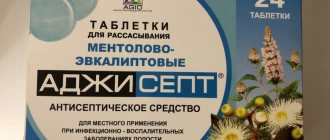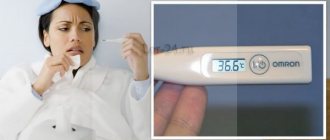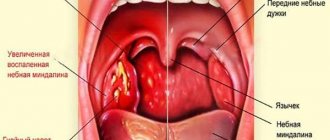If a sore throat is diagnosed in an infant, treatment should begin immediately. In this case, consultation and observation by a specialist are required. This is a rather dangerous disease that can cause a lot of complications. Sore throat in children under one year of age is quite rare. The first months after birth, their body is protected by immunoglobulins received from the mother. Then the baby’s own immune system begins to form. At the initial stage of life, it is still imperfect. Because of this, the child’s body is vulnerable and cannot always resist infection of any origin. The disease can occur at any time of the year. Even a sunny summer is not a guarantee that a child will not get a cold. The situation is aggravated by the fact that young children cannot talk about their feelings. That is why you need to know the symptoms of sore throat in order to identify it at the very beginning of its development.
Symptoms of the disease in infants
Signs of the disease are quite difficult to recognize, since in the first months of life the baby constantly cries due to discomfort caused by the body’s adaptation to the environment.
Signs of health problems caused by tonsillitis may include:
- General restlessness and constant crying. This behavior is caused by severe pain, which is accompanied by inflammation of the tonsils.
- Refusal to eat. This happens reflexively, since swallowing is accompanied by pain and discomfort.
- Increased salivation. It is caused by difficulties with eating and general inflammation of the oral cavity when purulent processes occur in the tonsils.
- Enlarged lymph nodes. In most clinical cases, the lymph nodes located under the lower jaw are enlarged. Touching them causes pain, which can be seen in the child’s behavior.
- A sharp increase in body temperature. Depending on the age and health of the baby, this figure can reach 38-40°C.
- Convulsions of the upper and lower extremities. This is a sign that the patient's body temperature has reached a critical limit.
- Changing the timbre of your voice. Inflamed tonsils also have a negative effect on the vocal cords. Under the influence of purulent discharge, the patient's voice becomes dull and hoarse.
- Vomiting and diarrhea. The cause of such deviations may be high temperature or pus that is released from the tonsils. A similar reaction can also be caused by severe pain.
- Redness and enlargement of the tonsils. In some cases, they become covered with a whitish coating or purulent plugs.
Depending on the form of sore throat, symptoms manifest differently. The disease can occur without a strong enlargement of the tonsils and an increase in temperature. It depends on the type of infection and the cause of the disease.
Symptoms of sore throat in infants
Sore throat is an infectious disease that is dangerous to health, especially when it occurs in young children. Lack of adequate treatment leads to complications and damage to various internal organs. Sore throat in infants occurs under the influence of staphylococci, streptococci, and less commonly, viruses become the causative agent of the disease.
This question interests all parents whose children have been given a similar diagnosis. Yes, indeed, acute tonsillitis knows no boundaries and does not select the patient based on gender or age. The disease occurs regardless of these factors, including in infants.
Young children are most susceptible to the development of sore throat because they have an underdeveloped immune system, which in most cases is unable to protect the baby’s body from the invasion of pathogenic microorganisms. Statistics show that children under three years of age more often suffer from diseases of viral etiology; 85–90% of those admitted are children under 3 years of age.
Dangerous pathology in children is extremely rarely associated with the penetration of bacteria; in children under one year old, bacterial infections can be counted on the fingers of one hand. Young children can contract a serious illness not only from an adult in the family or an older child, but also on the street. Sore throat is transmitted by airborne droplets. A person passing by a stroller with a baby only needs to sneeze once, and the virus will enter the baby’s body.
But newborn babies do not suffer from this disease.
- Firstly, a newborn baby is considered to be a baby in the first 28 days of life.
- Secondly, tonsils begin to develop at 6 months. That is, acute tonsillitis in children who are less than six months old cannot be detected due to the anatomical characteristics of the body.
Infants get tonsillitis not as often as children aged 3–7 years. The clinical picture is the same in young children. Inflammation of the tonsils begins with a sore throat, then pain and cough.
Attention! There is no runny nose with a sore throat. If a child has secretory nasal discharge, it means the diagnosis is incorrect.
It is difficult to diagnose children under three years of age. The difficulty is that an infant cannot say that it hurts. Most children begin to talk after three years of age. Having examined the throat, the pediatrician will detect a reddened throat if it is catarrhal sore throat, which has the mildest course and ends without complications.
General signs of acute tonsillitis:
- a sharp increase in temperature for no apparent reason, it rises to 40 degrees;
- febrile convulsions appear against the background of fever;
- chills are observed;
- the child becomes sleepy and lethargic;
- constant crying indicates that something is bothering the baby;
- lymph nodes are slightly enlarged;
- symptoms of intoxication occur.
Sore throat is accompanied by severe pain in the throat. Accordingly, the child refuses to eat and asks to drink more, because liquid is easier to swallow. The baby's throat becomes red, and a change in the color of the pharynx and the back of the throat is often observed. With a mild course of the disease, a white-yellow coating is detected, which begins to disappear after 2-3 days from the start of taking antibacterial medications.
Herpes sore throat in infants is more severe than catarrhal. The causative agent of the disease is the Coxsackie virus. The peculiarity of the disease is muscle and stomach pain. In the first few days after the end of the incubation period, a small red rash appears on the palate and back wall of the pharynx, which later transforms into pustules with serous contents. The child complains of headaches and diarrhea. The baby's stomach often stops, resulting in heaviness in the stomach and lack of appetite.
Purulent tonsillitis in infants can be follicular or lacunar. In the second case, pus completely fills the pockets and ducts of the tonsils. Follicular tonsillitis, like lacunar tonsillitis, is acute. These forms of the disease are characterized by hyperthermia up to 39–40 degrees, purulent spots on the tonsils, and pain radiating to the ear.
There is also a viral sore throat. Most often it goes away on its own and does not manifest itself in any way.
Why is a sore throat dangerous? The infectious disease is serious and dangerous. Untimely treatment contributes to the spread of pathogenic microorganisms and damage to internal organs.
The disease must be treated, otherwise it will cause complications in vital organs. This outcome of events could end disastrously. The baby is at risk of death. It is in the interests of parents to provide timely assistance to the baby.
How to avoid infecting your baby? Unfortunately, it is impossible to predict which person has a sore throat. For prevention purposes, it is recommended to avoid hospitals during periods of high risk of contracting respiratory diseases; it is better to call a doctor at home. Try to avoid hypothermia and avoid visiting places where there are large crowds of people in the autumn-winter period. An older child has a sore throat, how can you protect your baby? Children should be placed in different rooms, or better yet, the healthy one should be sent to grandma.
Is it possible to infect a baby if you place children in different rooms that are far from each other? The disease is transmitted by airborne droplets; even if a sick child remains in his room during treatment, bacteria can enter through small cracks in the door. In any case, the older child goes out to the toilet or to eat. Therefore, it is better to take the baby to his sister or grandmother until the older one fully recovers.
Acute tonsillitis responds well to treatment. Antibiotics for infants are prescribed by the pediatrician after examining the child. How to treat a sore throat? Small children under one year of age are prescribed penicillin-type antibacterial drugs. Medicines are inexpensive and administered intramuscularly. Most often, sick children are taken to the hospital; the doctor must monitor the baby’s condition, since there is a risk of complications.
Babies need to drink a lot often. Drink only warm liquids; drinking plenty of warm liquids will help avoid dehydration. Children over two years old can be given a decoction based on rose hips, or make tea with lemon or raspberries. It is important to take probiotic medications, as well as vitamin complexes to boost immunity. Treatment also consists of inhalation therapy. It is carried out using a nebulizer and medications. An infant should not be inhaled with potatoes; the steam will burn the mucous membrane and worsen the disease. Also, at elevated temperatures, you should not bathe or take your child outside.
Regarding food, Dr. Komarovsky recommends preparing it more liquid. Food should not be sour, spicy, or too salty. If you use traditional methods of treatment, it is not recommended to use compresses, ointments and thermal inhalations for sore throat accompanied by purulent discharge.
Sore throat in infants is a dangerous phenomenon that is fraught with serious consequences, especially if the disease is not detected in time. Translated from Latin, angina means “to press, squeeze,” which fully justifies this name. The disease occurs as a result of various infections, primarily affecting the tonsils. The clinical picture of angina may not be clearly expressed. Basically, the disease lasts about two weeks in the acute phase, the recovery period lasts up to four weeks.
Sore throat in an infant can occur as a result of:
- hypothermia;
- decreased immunity;
- viral infection;
- infection by airborne droplets.
When hypothermia, which contributes to the appearance of a cold, immunity decreases, which can lead to a sore throat. Any infection must be treated so that it does not lead to such a serious illness as tonsillitis.
An ill mother should continue to breastfeed her baby.
If the baby’s mother or one of the family members shows signs of the disease: redness and pain in the throat, fever and other symptoms, then there is a very high probability that the infant may become infected. To prevent the baby from becoming infected, the mother needs to do her own treatment and take the following methods: disinfecting her hands and breasts before feeding, gauze bandages, and frequent ventilation of the room.
A sick mother should not stop breastfeeding, since breast milk contains antibodies that provide immunity to the baby. In addition, sore throat can develop as a result of diseases such as laryngitis, pharyngitis, and otitis media.
Discomfort is clearly noticeable in the behavior of an infant: decreased appetite or complete refusal to eat, tearfulness, lethargy, signal that the child is sick. A few more symptoms that can help you determine that your baby has a sore throat:
- the baby is capricious, puts his fingers in his mouth;
- swallows saliva with a painful grimace;
- there is redness of the throat;
- the temperature rises.
Only a doctor can make such a serious diagnosis, so you should not hesitate to visit the hospital. The baby should be given as much rest as possible and not overloaded with active games.
There are several types of sore throats:
- catarrhal;
- follicular;
- fungal;
- diphtheria.
Infants under one year of age most often face a catarrhal form of sore throat. This may be a consequence of hypothermia or cold drinking. The child's throat becomes slightly red, swallowing becomes difficult, and the temperature may rise slightly. If the mother notices deviations in the baby’s behavior in time, treatment will not last more than five to seven days.
A severe course of the disease is characteristic of follicular tonsillitis, which occurs with a very high temperature and pronounced purulent plaque on the tonsils. In addition to the throat, the child has a headache, muscles and joints; due to the high temperature, convulsions may begin. Delaying treatment can threaten the kidneys and heart of newborns.
With fungal tonsillitis, a “curd” coating appears on the tonsils, the temperature does not rise, but swallowing is painful. Sore throat, which occurs when infected with diphtheria bacillus, is extremely rare. Urgent measures are required to save the infant.
If you notice any symptoms of a sore throat in an infant, you should immediately contact a pediatrician or ENT specialist. You cannot treat without a comprehensive examination. The doctor examines the pharynx and palpates the lymph nodes. A blood test is taken to determine ESR and the number of leukocytes. A throat swab for bacterial culture will help identify the causative agent of infection and determine drug resistance.
As soon as you notice the first signs of a sore throat in your baby, you should immediately call a pediatrician. In case of a prolonged increase in temperature to 38.5-39 degrees, seek emergency help.
You should not self-medicate, but if you decide to give an antipyretic, remember: under no circumstances give aspirin to small children! Serious complications may occur.
There are children's medications based on paracetamol or ibuprofen; before use, read the instructions and strictly follow the dosage. There is no need to cover the child with a warm blanket, this will only make the child worse. You need to humidify the air in the room to make your baby's breathing easier. Drinking plenty of warm tea, fruit drinks, and drinks will help improve your condition.
In the event that the baby’s condition allows the little patient to be treated not in a hospital setting, but at home, the mother or relatives take care of him. To avoid infecting other children, a sick baby must be isolated.
Here are some care tips:
- bed rest at high temperatures;
- walks in the fresh air at a temperature not exceeding 37 degrees;
- ventilation of the room where the child is (temperature no higher than 20 degrees);
- wet cleaning every day;
- light mushy or liquid food;
- frequent breastfeeding.
To determine the type of disease, you need to take a swab from the throat and nose. Treatment consists of antimicrobials or antibiotics. The prescription of medications directly depends on the type of sore throat, which is caused by viruses or bacteria.
For angina, no expensive and exclusive drugs are required - ordinary penicillin, ampicillin, erythromycin are still highly effective in doses and forms prescribed by the doctor.
Plenty of warm drink in the form of raisin decoction, dried fruit compote, herbal tea, non-sour juices, water. Menthol ointment, rubbed on the baby's chest, reduces sore throat. Rinsing for infants is an impossible procedure. To ease your baby's suffering, you can give one teaspoon of chamomile tea every hour during the day. You can spray the pacifier with a medicinal antiseptic solution and give it to your baby.
For small children, antipyretic drugs are produced in the form of syrups and suppositories: ibuprofen, nurofen, bofen, paracetamol, panadol, efferalgan. Various vitamins are also used to strengthen the immune system: multi-tabs, picovit. After taking antibiotics, probiotics are prescribed to restore intestinal flora: Linex, Bifiform.
The device sprays the medicine into a liquid mist that is easily inhaled. Gently place the mask on your child's mouth and nose.
You can keep it at a certain distance so as not to scare the baby, sing him songs, rock him slightly, distracting him from an unfamiliar object. Hold until the medicine is completely sprayed. If your child is frightened by the noise of the machine, place a thick layer of cloth under the base to reduce the sound, or use a longer tube to be further away from the machine.
Sore throat is a serious infectious disease. Having identified the signs of a sore throat in a baby in time, you need to immediately begin treatment to avoid complications such as:
- acute otitis and laryngitis;
- swelling of the larynx;
- peripharyngeal abscess;
- cervical lymphadenitis;
- meningitis;
- rheumatic fever;
- glomerulonephritis;
- sepsis;
- pneumonia.
Disorders of the cardiovascular system may also occur, problems in the nervous system may occur, and malfunction of the musculoskeletal system may occur.
To prevent your baby from getting a sore throat, all family members should follow the rules of personal hygiene, avoid contact with sick people, not visit medical institutions on the day of admission of sick children, and follow simple hygiene rules:
- maintain a certain humidity in the room where the baby is, if necessary, install a special humidifier;
- Ventilate your child’s room systematically, even in winter, open the window a couple of times a day.
In order for a baby to have a strong immune system, its diet must be complete, containing all the necessary vitamins, microelements, proteins, and carbohydrates. If a mother is breastfeeding her baby, then she needs to eat right. A nursing mother's menu should consist of healthy foods and not contain fatty, spicy, or allergenic foods.
You should not self-medicate a little person; you should use medications wisely, treat a sick child in a timely manner, without turning the disease into a chronic disease.
Engage in physical exercises with your child, strengthen them from birth. Sore throat can be cured relatively quickly, but it is very exhausting for both the little one and the mother.
Even babies are not immune from infections
Sore throat (tonsillitis) is an acute inflammation of the tonsils. Although pediatric doctors constantly encounter this infection, it is not entirely typical for children under 1 year of age: more often at this age, children can be diagnosed with rhinitis or pharyngitis. Why does a baby develop sore throat, what health hazards does it pose, and how can you defeat the disease faster? You will find answers to these questions in this article.
About 70% of cases of sore throat in infants are viral in nature.
The most common pathogens of the disease are:
- rhinovirus;
- adenovirus;
- coronavirus;
- cytomegalovirus;
- herpes virus;
- Epstein-Barr virus.
Bacterial tonsillitis, which predominates in adults and children over 5 years of age, occurs in infants no more than in a third of cases. The main pathogen is beta-hemolytic streptococcus.
Differences between bacterial and viral sore throat
Does sore throat occur in infants? Although this disease is more common in children over 3 years of age, sometimes tonsil inflammation is diagnosed in children under 1 year of age.
Tonsillitis in infants is severe, with severe symptoms of intoxication and general manifestations. Therefore, it is important to consult a doctor for timely diagnosis and treatment of the disease.
Symptoms of sore throat in infants (regardless of the pathogen):
- acute onset - the temperature rises sharply to 39-40 degrees, the child becomes lethargic and drowsy. Refusal to breastfeed at this point is a dangerous sign that should cause you to seek medical help immediately;
- constant crying;
- refusal to breastfeed, any food or drink;
- loose stools;
- chills, vegetative reaction (the baby’s skin can be very pale, moist, or bright red, hot);
- swelling, redness of the pharynx, uvula and tonsils (see Tonsils in the throat: how inflammation occurs);
- sometimes a purulent white coating on the surface of the tonsils.
Sore throat in an infant is often accompanied by high fever
The difficulty of differential diagnosis of viral and bacterial sore throat in infants lies in the fact that these symptoms of these pathologies are very similar. To reliably find out which pathogen caused the infection and begin proper treatment, it is necessary to conduct a bacteriological examination of a smear from the oropharynx.
If a smear analysis shows colonies of beta-hemolytic streptococcus, it means that the sore throat is bacterial in nature and can be treated with an antibiotic. A negative result in 90% of cases indicates that the baby’s illness is caused by a virus. An experienced doctor can guess the type of pathogen based on the clinical picture.
Signs of a sore throat in a baby caused by viruses:
- severe catarrhal symptoms - clear mucus discharge from the nose, cough;
- often – concomitant conjunctivitis;
- tonsils are bright red, with or without a white coating, the pharynx is loose.
Sore throat caused by streptococcus is different:
- minimum catarrhal manifestations of the disease;
- absence of cough;
- enlargement and tenderness of the cervical lymph nodes.
Note! It is important to understand that all the information, photos and videos in this article are not instructions explaining how to treat a sore throat in an infant. Only the basic principles of therapy for this disease are discussed here. If your child experiences any symptoms of tonsillitis, contact your doctor immediately.
Regardless of the pathogen, treatment of sore throat in an infant should begin with the following measures:
- Offer your baby the breast as often as possible. It is also advisable to give him warm water, compote or chamomile decoction (1 teaspoon every half hour);
- If the temperature exceeds 38°C, be sure to give the baby an antipyretic. Products based on Paracetamol or Ibuprofen are safe for him.
- Solutions of approved antiseptics (Furacilin, Miramistin (see How to use Miramistin for the throat), Chlorophyllipt) are used as local therapy. They are diluted in water according to the instructions and used to treat the baby’s mouth and pharynx 3-4 times a day. The most convenient way to do this is with a cotton swab or sterile gauze wrapped several times around your finger.
- Many pediatricians prescribe medications such as Ingalipt, Tantum Verde, and Hexoral to reduce inflammation in the throat. Since these medications come in spray form and are inconvenient for a baby to use (and can even be dangerous!), they are sprayed onto a pacifier and then given to the baby.
Mother's milk is the best source of nutrients and immune protection for the baby
Table 1: Drugs approved for use in infants:
| Name | Release form | Medicinal action | average price |
| Furacilin | Tablets for preparing the solution | Antimicrobial | 60 rub. |
| Miramistin | Solution for external use | Antiseptic | 215 rub. |
| Tantum Verde | Solution for topical use | Pain reliever Anti-inflammatory | 290 rub. |
| Hexoral | Solution for topical use | Antiseptic Deodorizing Painkiller Antifungal | 280 rub. |
The danger of bacterial tonsillitis in an infant lies not only in the severity of the disease itself, but also in the serious complications that develop with improper treatment.
Tonsillitis in an infant can be complicated by:
- glomerulonephritis (severe kidney disease);
- acute rheumatic fever;
- septic arthritis;
- paratonsillar abscess.
Therefore, as soon as it becomes reliably known that a baby’s sore throat is bacterial in nature, it is necessary to prescribe antibiotics:
- penicillins (Amoxicillin, Amoxicillin + Clavulonic acid);
- cephalosporins (Cefazolin, Cephalexin);
- macrolides (Clarithromycin, Erythromycin, Josamycin).
Sumamed is a popular antibiotic from the macrolide group
The course of treatment with antibiotics for angina takes from 5 to 10 days. If the child’s condition is satisfactory, the mother can give him medicine in the form of a suspension, which can be easily prepared with your own hands by mixing granules produced by manufacturers with clean boiled water.
If the baby's condition is serious, treatment is usually carried out in a hospital setting, and antibiotics are prescribed in injection form.
There is no specific treatment for viral sore throat. Breasts are treated according to general principles. If the disease drags on, the doctor may prescribe the baby one of the immunomodulatory drugs - Viferon, Interferon, Genferon to stimulate the body's defenses.
Thus, tonsillitis is a serious disease that cannot be ignored. If you notice the symptoms that we mentioned above in your child, be sure to consult a doctor: treatment of sore throat in infants should be comprehensive and as safe as possible.
Sore throat is a dangerous infectious disease that affects the mucous membrane of the tonsils, and also has serious consequences for the entire body. The fact of the disease itself is not very pleasant at any age, but the greatest concern is when a sore throat occurs in an infant.
A sore throat in an infant can go unnoticed for quite a long time. It all depends on the type of disease developing, its causes and symptoms. We'll talk about this in this article.
It is difficult to distinguish the symptoms of a disease such as tonsillitis in an infant. The child cannot report the pain that is tormenting him, and this complicates the recognition of the disease.
However, due to the fact that tonsillitis is an acute form of a disease such as tonsillitis, when it manifests itself, other, more obvious signs are observed that affect both behavior and physical characteristics. Behavioral symptoms include:
- restless atypical behavior;
- refusal to eat and drink;
- crying, worse when eating.
Indirect signs of the disease also include: vomiting, bloating, diarrhea. As for the symptoms that affect the baby’s physical condition, they include:
- significant increase in body temperature;
- fever and chills, manifested in convulsions;
- enlargement of the cervical and submandibular lymph nodes;
- swelling and redness of the tonsils.
In some types of the disease, plaque or purulent formations may be observed on the tonsils,
redness of the back of the throat. The formation of white ulcers filled with pus indicates the development of a disease such as purulent tonsillitis in the infant. The period of the disease in infants usually lasts about 12-14 days.
The cause of the development of the disease in an infant is the microorganisms that cause the disease. Most often, they become staphylococcus or streptococcus bacteria, less often - various types of viruses (herpes, adenovirus, etc.).
They enter the baby's body through airborne droplets upon contact with a carrier of the infection. And the direct growth and degeneration of the pathogen into a disease occurs when the child’s immunity is weakened.
This answers the frequently asked question about whether a baby can get a sore throat, and is a reason to carefully protect the baby from contact with such people. After all, in a child’s body the disease progresses faster and lasts longer.
The symptoms of a disease such as tonsillitis in an infant and its treatment are closely related. Since, depending on the cause that provoked the disease, the course to combat it will be different.
The first thing a mother of a small child needs to do when the first symptoms of acute tonsillitis are detected is to consult a doctor. Because only a qualified specialist is able to determine the type of disease, its stage and prescribe the medications necessary in this case.
Under no circumstances should you independently treat a child based on your own or others’ experience, or, even worse, on advice from the Internet. The consequences of a disease such as tonsillitis in an infant can cause serious disruptions in the functioning of the body or even lead to the development of fatal forms of disease.
Treatment of a disease such as sore throat in an infant, caused by bacteria, despite the age of the child, requires the use of antibiotics. Only antibacterial drugs are able to cope with the cause of the disease and completely eradicate it from the baby’s body.
Despite the fact that treatment of acute tonsillitis in older patients requires outpatient treatment, tonsillitis in an infant is a serious reason for treatment under inpatient observation.
As for the treatment process itself, it is necessary to comply with the necessary conditions for the child’s recovery. Namely:
- strict bed rest is required;
- to combat temperature changes, you need to drink plenty of fluids;
- in the room where the child is located, regular wet cleaning and ventilation must be carried out;
- control and maintain the level of humidity in the room;
- carry out medical procedures prescribed by the attending physician;
- taking all medications prescribed by a specialist.
Causes of the disease
The baby’s immune system is not sufficiently formed and is not able to reliably protect him from the influence of external and internal factors.
A child may develop a sore throat for the following reasons:
- Severe hypothermia. Hypothermia occurs due to the child being in a draft or the wrong choice of clothing. Quite often, parents dress their children very warmly, considering this to be reliable protection from frost. As a result, the child sweats, his clothes become wet and lose their thermal insulation properties. Freezing leads to weakening of the body and the occurrence of inflammatory processes.
- Insufficiently thought out diet. After birth, a baby needs a lot of nutrients to grow. If children do not receive the required amount of minerals, proteins and vitamins, then their immune system loses the ability to fight pathogens.
- Severe fatigue. It can be caused by long trips, a stay in a children's clinic, renovations in the apartment, or excessive attention from parents. Prolonged activity greatly weakens the child's vitality.
- Sedentary lifestyle. Many parents neglect children's gymnastics and walks in the fresh air. Such inattention to the baby leads to stagnation and a general weakening of his body.
- Eating excessively cold food or drinks. The risk of sore throat is especially high if it occurs in the summer during extreme heat. Given the contrast between an overheated body and icy foods, there is a high risk of tonsil disease.
- The presence of inflammation and purulent processes. A sore throat can be caused by sinusitis, sinusitis, adenoids or caries. The tonsils may not be able to cope with the abundance of viruses and bacteria, becoming a source of infection.
- Complications after infectious diseases. Pathogenic organisms can enter the tonsils during treatment for influenza or ARVI.
- Infection by airborne droplets from a carrier of infection. This can happen while walking around the city, traveling on public transport, or when visiting crowded places. The risk of infection increases in the autumn-winter period, when mass diseases begin.
Left untreated can have serious consequences for the baby's health.
Symptoms
Detecting a sore throat in a baby can sometimes be quite difficult. After all, a small child cannot yet talk about his health. Therefore, it is necessary to take a closer look at the baby’s behavior.
A sick child becomes capricious and whiny. He doesn't sleep well and refuses to feed because of a sore throat. In such cases, it is necessary to measure the baby’s temperature and examine his tonsils. If the baby has redness or pustules, then it is necessary to show the child to the pediatrician.
Let's look at the symptoms of tonsillitis in infants depending on the type of disease.
Catarrhal tonsillitis occurs most often in infancy. This disease is accompanied by severe inflammation of the tonsils without suppuration. The child’s temperature rises to +37 - +38 degrees. Sore throat is moderate. The tonsils are covered with mucus and look red and swollen. There is a slight enlargement of the lymph nodes. This is the mildest form of the disease.
Purulent tonsillitis in infants is much more severe. The temperature rises to +38 - +39 degrees. There is a severe pain in the throat that radiates to the ears. Lymph nodes are not only enlarged, but also painful. White or yellowish dots may be seen on inflamed tonsils. Follicular purulent tonsillitis occurs in children older than 6 months. It is at this age that the baby’s tonsil follicles form. Lacunar purulent tonsillitis is accompanied by the same symptoms, but pus accumulates in the pockets of the tonsils (lacunae).
Ulcerative membranous tonsillitis is very rare in infants. Body temperature with this disease may be slightly increased. Ulcers and plaque in the form of grayish-white films form on the tonsils. There is an unpleasant odor from the mouth.
With phlegmonous sore throat, there is severe swelling and suppuration of one of the tonsils. Body temperature can rise to +39 - +40 degrees. It becomes very painful for the child to swallow and make sounds.
Complications in young children
The body of a small child is in the stage of growth and formation. Any external factors can lead to serious deviations in his physiological and mental development.
Incorrect treatment provokes the following complications:
- chronic tonsillitis;
- rheumatoid arthritis;
- heart disease;
- cirrhosis of the liver;
- renal failure;
- phlebeurysm;
- tachycardia and hypertension;
- diabetes;
- poor blood clotting;
- rheumatic heart disease;
- phlegmon of the neck.
Pathological deviations can begin at one of the stages of the disease. The child's consciousness may be confused, breathing and coordination of movements may be impaired. In such cases, urgent hospitalization is necessary. It is likely that ventilators and artificial circulation may be required. Delay in receiving medical help can be fatal.
Doctor Komarovsky about sore throat in children
Sore throat is called inflammation of the tonsils and mucous membrane of the pharynx. In preschool children, the disease occurs very often, which is associated with the low reactivity of the body. How does Dr. Komarovsky treat sore throat in children?
A well-known practicing pediatrician is convinced that therapy for ENT diseases can be carried out only after an accurate diagnosis.
Local and general symptoms of tonsillitis are similar to the manifestations of scarlet fever, measles and other pathologies. To find out the nature of the inflammation, you need to undergo examination by an experienced specialist.
Only based on the results of bacterial culture from the throat can the causative agent of infection be identified and the optimal course of treatment determined.
The sooner therapy is started, the lower the risk of developing post-infectious complications.
What is immunity?
Immunity is the body’s ability to resist pathogenic viruses, protozoa and bacteria. The tissues of the human body are made up of several groups of cells that perform specific functions.
For example, lymphadenoid tissues take part in the formation of immune defense. They are localized in the thymus gland, small intestine and bone marrow.
You can visually see lymphadenoid formations (palatine tonsils) in a child in the throat behind the palatine arches.
Absolutely all substances that enter the body with air or food are “controlled” at the level of the tonsils. Pale pink paired organs regularly encounter foreign agents, some of which are harmful. Tonsillitis is a disease that occurs as a result of damage to the tonsils (palatine tonsils) by pathogenic bacteria or viruses.
Common pathogenic microorganisms include:
- rhinoviruses;
- streptococci;
- herpes viruses;
- staphylococci;
- adenoviruses;
- pneumococci.
As a result of the active proliferation of pathogens in the ENT organs, inflammatory processes occur, accompanied by hyperemia and swelling of tissues. The child experiences general signs of intoxication and enlarged lymph nodes, which indicates the development of pathogenic flora in the body.
Catarrhal sore throat
Catarrhal tonsillitis is one of the most common infectious diseases found in children. A relatively mild form of pathology with timely and competent treatment resolves without complications within 5-7 days. The infection is transmitted primarily by airborne droplets and contact through household items, toys, etc.
Dr. E.O. Komarovsky claims that the clinical manifestations of ENT disease in children are more pronounced than in adults. This is due to sensitization of the child’s body, i.e. tendency to allergic reactions. The main symptoms of inflammation of the pharynx mucosa include:
- enlargement of the palatine tonsils;
- pain in the throat and head;
- hyperemia of the pharyngeal mucosa;
- painful swallowing;
- temperature increase;
- enlarged lymph nodes;
- general weakness; lack of appetite.
Important! If the disease is not treated in a timely manner, inflammation of the salivary glands occurs, which leads to intense salivation.
How is angina in children treated? Komarovsky warns that therapy for patients under 2 years of age should be carried out under the constant supervision of a physician, i.e. in the hospital. Self-medication often causes the progression of the disease and the development of local and sometimes systemic complications. The child may experience convulsions, shooting pains in the ears, rhinitis, pyelonephritis, etc.
It should be noted that catarrhal tonsillitis can provoke the development of purulent processes in the tonsils. Delayed treatment of pathology leads to an increase in the number of pathogens in the palatine tonsils and a decrease in local immunity. If catarrhal processes are not stopped within 3-4 days, the patient may develop follicular or lacunar tonsillitis.
Sore throat in infants
Newborns and infants are more susceptible to infectious diseases than others, which is due to the lack of adaptive, i.e. acquired immunity.
It is the presence of immunological memory that allows the human body to suppress the development of pathogens.
But since the infant has never previously encountered bacteria and viruses that provoke tonsillitis, he will certainly get sick.
Catarrhal tonsillitis in infants is practically asymptomatic, so it is not always possible to start treatment on time. The development of an ENT disease can only be signaled by clinical manifestations such as:
- low-grade fever;
- tearfulness and poor sleep;
- refusal to eat;
- hyperemia of the oropharyngeal mucosa.
Improper treatment of tonsillitis can cause the development of rheumatic fever, characterized by damage to the heart muscle and joints.
If the disease is not diagnosed in time, within 2-3 days the catarrhal processes in the tonsils will turn into purulent inflammation.
Due to the hypersensitivity of the child’s body to antibacterial drugs, it will not be possible to cure a purulent sore throat immediately, but within at least 7-10 days.
Baby care
Drug therapy is only one of the components of the treatment of infectious-allergic sore throat. To prevent the child from having serious complications later, he needs to be provided with special care. Compliance with the pediatrician’s recommendations does not guarantee immediate elimination of the symptoms of the disease, but minimizes the risks of post-infectious consequences:
- bed rest – prevents serious stress on vital systems and organs during the period of exacerbation of inflammatory processes;
- drinking plenty of fluids prevents dehydration and increased symptoms of general intoxication;
- regular ventilation and cleaning - minimizes the risk of irritation of the throat mucosa with dry air;
- rubbing the chest with menthol ointment helps relieve discomfort in the throat.
Important! The principles of treating infants with folk remedies must first be agreed with the pediatrician.
It is recommended to give children fortified drinks, the use of which helps to compensate for the lack of nutrients in the body. Warm tea with honey, a decoction of medicinal herbs, fresh fruit juice and milk are the best immunostimulants.
Principles of therapy
To eliminate catarrhal processes in a child’s throat, it is necessary to provide comprehensive treatment using pathogenetic and palliative drugs, i.e. symptomatic action. Drugs of the first group are aimed at destroying pathogenic flora, and the second - at relieving general and local symptoms of pathology.
Treatment of children under 2 years of age is best done in a hospital setting under the supervision of a specialist.
As part of drug therapy, the patient is prescribed the following types of medications:
- antibiotics – destroy pathogenic microbes;
- antiviral agents – prevent the proliferation of viruses;
- local antiseptics - disinfect the throat mucosa;
- anti-inflammatory drugs - accelerate the regeneration of lymphadenoid tissues;
- antipyretics – eliminate low-grade and febrile fever.
Only the attending physician can prescribe medications, based on the patient’s medical history and the results of throat culture. An overdose of antibiotics can lead to deterioration of health and the development of late post-infectious complications, 50% of which are systemic.
Choice of antibiotic
What antibacterial medications should be used to treat sore throat in children? According to E.O. Komarovsky, in the initial stages of the disease, it is more advisable to use penicillins.
They are highly resistant to streptococcal infections, which often cause serious post-infectious complications.
In approximately 70% of cases, angina in children is provoked by beta-hemolytic streptococcus.
The dosage of drugs is determined by the patient’s weight, the shape of the sore throat and the degree of spread of inflammatory processes in the oropharyngeal mucosa.
On average, the course of antimicrobial therapy is 7-10 days. The most effective and safest antibiotics include:
- "Amoxicillin";
- "Augmentin";
- "Ecoclave".
Speaking about sore throat, you need to remember that it occurs against the background of the development of nonspecific bacteria. Some of them are capable of producing a special enzyme that protects them from the effects of penicillin drugs. If there is an allergy or the drug is ineffective, penicillins are replaced with macrolides: Hemomycin, Sumamed, Macropen, etc.
If, before the development of tonsillitis, the child was repeatedly treated with drugs from the above groups, the pathogens could develop resistance to the active components of the antibiotics.
If penicillins and macrolides are ineffective, the child is prescribed cephalosporins: Suprax, Cefurus and Zinnat. They are quite toxic and therefore often cause allergic reactions.
However, it is cephalosporins that have a wide spectrum of action and are insensitive to beta-lactamases and penicillinases - enzymes that inactivate penicillin drugs.
Local treatment
Catarrhal inflammation of the throat is characterized by damage only to the superficial layers of lymphadenoid tissue. According to E.O. Komarovsky, pathological processes can be stopped with the help of local antiseptic solutions. They contribute to the regression of inflammation and the acceleration of epithelization of the mucous membrane, due to which discomfort in the throat, hyperemia and swelling disappear.
Important! You should not gargle or irrigate the throat of children under 2-2.5 years of age.
In pediatric therapy, the most effective and safe topical medications include: Chlorophyllipt; "Miramistin"; "Normoflorin"; "Furacilin"; "Stopangin."
In the absence of pharmaceuticals, you can prepare a soda solution for rinsing. Irrigation of the throat with soda helps to increase the concentration of alkali in the mucous membrane, which is an unfavorable environment for the development of bacteria. Regular rinsing with a non-concentrated soda solution within 2-3 days will eliminate local manifestations of the disease.
Huseynova Irada
Sources: medscape.com, health.harvard.edu, medicalnewstoday.com.
Source: https://globalmedclub.ru/angina/rebenok/doktor-komarovskij-lechenie-u-grudnichkov.html
Diagnosis of the disease
Since angina can occur in different forms, it is treated with various methods, medications and medications. To select the most effective means of combating the disease, a comprehensive examination is carried out, during which an accurate diagnosis is determined.
The study of the patient’s condition is carried out in the following sequence:
- Questioning parents about the symptoms that the child showed. During the conversation, the specialist finds out the possible causes of the disease and its course.
- Examination of the patient. The main focus is on examining the tonsils and nasal passages. Lymph nodes are palpated, body temperature and blood pressure are measured.
- Blood is taken for analysis. Based on its results, a conclusion is made about the presence of inflammation and the pathogen that provoked it.
- In the presence of purulent processes, a smear is taken from the mucous membranes of the throat and nasal passages. This allows you to determine the type of virus that affected the baby.
If necessary, the patient is prescribed fluorography or a study using a magnetic resonance imaging device. The pictures will help the doctor determine how much the lungs, heart and internal organs are modified. These activities are carried out only in a clinical setting. It is better to take your child there by your own car or by taxi. You should not take a sick patient to the hospital on public transport or in a wheelchair. Such a load can significantly worsen the situation.
Features of treatment for children under one year old
Sore throat in an infant is treated under the supervision of doctors. The pediatrician or ENT specialist will select treatment methods, the necessary medications, their dosage and course duration, depending on the degree of development of the disease and the age of the child. You should not do this yourself, as a small organism may unexpectedly react to medications.
Help at home:
When treating a sore throat in an infant, antibiotics are needed. They reduce the risk of complications, the disease goes away easier and faster. Antibiotics are taken for at least a week. It is important to take the entire course of the drug, even if the symptoms of sore throat have disappeared. Most often, children are prescribed Penicillin in tablet form. This is an effective and inexpensive drug.
For ease of use, children under one year of age can use Amoxicillin in syrup form. Treatment with Sumamed, Macropen, and Cephalexin is also possible. All medications are used after consultation with a doctor.
In addition to antibiotics, to treat a sore throat, your doctor may prescribe:
- Antipyretic drugs: Ibuprofen, Paracetamol or Efferalgan in the form of syrup or suppositories. They will reduce high body temperature, significantly improving the child’s condition. Use according to the instructions for use, taking into account the age of the baby.
- Antihistamines. They are prescribed when an allergic reaction occurs.
- Antiviral: Viferon, Kipferon. Used to treat viral tonsillitis.
- Vitamins: Multi Tabs, Pikovit (in the absence of allergies).
- Probiotics: Linex, Bioform. They are prescribed to restore intestinal microflora after a course of antibiotics.
Local treatment is carried out using sprays, lozenges, syrups, and rinses. The difficulty in treating children under one year of age is that they cannot gargle and there is a risk of swallowing the tablet. Sprays should also be used with caution; it is better to spray the product on the inside of the cheek - then the medicine, along with saliva, will enter the throat. Basic medications:
- Rinse with salt and soda solution. Children under one year old can hold the liquid in their mouth and spit it out.
- Sprays: Hexoral, Tantum Verde, Ingalipt. Most sprays are approved for use from 3 years. In some cases, pediatricians prescribe them for the treatment of purulent tonsillitis.
- Lozenges: Doctor Mom, Faringosept. They are best used after 3 years.
- ingestion of infusions and decoctions of herbs: cranberries, lingonberries, currants, thyme with the addition of honey;
- gargling with solutions of citric acid, a decoction of bay leaves, sage, ginger;
- compresses.
Doctor Komarovsky about angina
Sore throat is an infectious disease with a syndrome of intoxication of the whole body. Suppuration of the tonsils and mucous membrane of the pharynx occurs. Quite often the disease is observed in preschool children. This is due to the slight reactivity of the body.
Komarovsky says about sore throat: do not confuse sore throat with other diseases, since the disease must be treated correctly. Otherwise, undesirable consequences and complications may occur.
Dr. Komarovsky had the opportunity to film many programs about angina, so it’s worth listening to all the recommendations.
What is a sore throat?
Sore throat is an acute infectious disease caused by pathogenic microbes, viruses and fungi. The most common microbes are streptococci. They enter the body through the mouth.
They may not reveal themselves for a long period. As long as the babies feel normal, the bacteria will not cause any inconvenience.
If it freezes, the immune system is weakened and bacteria begin to multiply quickly.
Is sore throat contagious? Sore throat is a contagious disease, so it is easily transmitted from one individual to another. You can become infected:
- through shared toys;
- personal hygiene items;
- through dishes;
- through bodily touch.
Viral sore throat has an incubation period of about 12 hours. Children usually become infected at 2 years of age. It is at 2-3 years of age that a child’s sore throat is most difficult to tolerate. It is possible for a baby to have a sore throat, but it will be very difficult for him. The innate immunity, which was transmitted from the mother, has already been used up, and our own has not yet been developed.
Symptoms of the disease
Komarovsky pays special attention to the symptoms of tonsillitis, since it is important not to confuse the symptoms with other diseases. In children, symptoms appear very quickly and aggressively. For this reason, sore throat is often confused with the flu. It is worth listening to Komarovsky about sore throat in children in order to learn to recognize the signs.
The manifestation of such signs will help parents:
- increase in body temperature up to 39 degrees;
- the appearance of severe pain in the throat;
- inflammation of the lymph nodes and their significant enlargement;
- tonsils become bright red;
- after infection, white plaque may appear on the tonsils;
- in severe cases of the disease, the amount of lymphoid tissue in the tonsil area increases.
If the symptoms of the disease are detected in a timely manner, antibiotics will not be needed. It is important to promptly contact your doctor to receive qualified assistance.
Types of sore throat
Depending on the stage of the disease, the general clinical picture and the nature of the symptoms, several types of the disease are distinguished:
- catarrhal, in other words tonsillitis;
- follicular or purulent tonsillitis;
- necrotic;
- fungal, in other words candidal tonsillitis.
Follicular form
Follicular tonsillitis in children is accompanied by a significant increase in body temperature, severe pain in the throat, and chills. A yellowish or greenish coating begins to appear on the tonsils.
Therefore, this form is also called purulent. When swallowing, the child experiences severe pain. In parallel with these symptoms, joint pain occurs. Lymph nodes enlarge significantly as the process of suppuration begins.
Recovery most often occurs on day 7.
Necrotic form
This form of the disease is accompanied by a very unpleasant odor from the mouth. With sore throat in children, a smell occurs due to the death of tonsil tissue. The affected areas become quite dense, and after they are eliminated, bleeding wounds remain.
After the dead areas are rejected, defects are formed. A whitish coating, ulcers, and a coating on the tongue appears. Suppuration appears not only on the tonsils, but also on the palatine arches. The duration of the disease can be more than a month.
When examining the child's blood, a significant increase in leukocytes is detected.
Fungal form
In terms of the degree of contagiousness, candidal tonsillitis ranks last. Adults very rarely develop this disease, so the disease is considered a childhood disease. Suppuration is caused by fungal spores. It is very difficult to recognize the disease by its symptoms. For proper treatment of sore throat in children, Komarovsky advises taking tests and conducting research on the flora that lives in the child’s throat.
Doctor Komarovsky about the disease
Evgeny Komarovsky claims that absolutely everyone has had a sore throat at least once or twice in their life. If the throat turns red and starts to hurt, this does not always mean that the child has a sore throat. This is how tonsillitis can manifest itself. This is suppuration of the tonsils, which is caused by airborne viruses.
With this disease, the tonsils are damaged in a special way. The severity of such a lesion distinguishes tonsillitis from tonsillitis. According to the doctor, the disease does not have a chronic form and cannot become exacerbated from time to time. The disease can only be acute.
Cure the disease
According to Komarovsky, sore throat is dangerous for others, so it is necessary to listen to all the doctor’s recommendations. It is impossible to determine the root cause of the disease at home, so examination by a specialist is important. Sore throat in children should only be determined by a specialist.
Each symptom of an illness can also manifest itself in other diseases, so only a doctor can quickly make the correct diagnosis. This will save the child from a number of complications. Timely treatment of the disease is required.
It is almost impossible to cure a sore throat without antibiotics, while tonsillitis only needs a boost in immunity. To treat a sore throat, Komarovsky first of all advises following a diet.
A well-known doctor gives several recommendations on how to alleviate the condition of children aged three years. Treatment Komarovsky offers the following:
- Be sure to visit your doctor for a diagnosis.
- Physical activity is prohibited, so if you are ill, it is very important to maintain bed rest.
- There is no need to look for special expensive drugs to cure the disease. Regular ampicillin, penicillin or erythromycin will come to the rescue.
- Take all antibiotics and antiviral drugs in strictly prescribed dosages. When the condition improves, you should not stop taking medications. An incompletely cured disease can lead to undesirable consequences.
- In children, treatment is possible using local methods: decoctions of chamomile, sage or soda solution. But it is worth remembering that these methods need to be included in the complex treatment of the disease. In this case, results can be expected much faster.
- Is it possible to cure a disease with rinsing alone? No. Rinsing procedures help eliminate plaque that occurs. Thanks to this, all pain disappears. The frequency of procedures is prescribed by the doctor on an individual basis. It all depends on the overall clinical picture. If you feel excessively dry, gargle after each meal.
- If the body temperature rises very strongly, then taking antipyretic drugs is effective. In case of severe sore throat, you can take painkillers.
- To moisturize your throat, you can take lozenges. It is impossible to cure the disease in this way, but medicinal lozenges will help eliminate the discomfort that arises.
- Constantly ventilate the room in which the patient is located. Carry out wet cleaning daily. Everyone should have individual dishes, as the disease is contagious.
If you follow all the recommendations, you can significantly speed up the patient’s recovery process.
Diet for sore throat
Evgeny Komarovsky advises the patient to follow a diet. There is no need to force your child to eat. Prepare only food that will not injure the tonsils. No need to use:
- acute;
- salty;
- hot;
- solid;
- rude.
Consume broths, cereals, mashed potatoes, fresh fruits and vegetables more often. The main thing is to drink plenty of warm fluids. You can replace water with:
- warm milk with honey;
- decoctions of medicinal plants;
- tea;
- compotes and fresh or dried fruits.
By following a diet, the baby’s recovery will be significantly accelerated. Do not neglect the advice so as not to harm the child’s body.
How to prevent a relapse?
The human body is very sensitive to viruses at a time when its immune system is weakened.
It is extremely important to adhere to a healthy lifestyle, eat right and not expose your health to negative factors.
Always dress appropriately for the weather, do not sit under air conditioners, and do not drink icy liquids. Since sore throat is contagious, you should not be in public places during epidemics.
Hardening is quite effective. But you need to master it under the supervision of your attending physician. Reduce the water temperature only gradually or the effect will be the opposite.
During illness, the child experiences very severe stress. Komarovsky gives advice on giving your baby his favorite toy. In this case, your mood will improve. After all, during a period of illness, children are deprived of their usual way of life, and a pleasant surprise will be a reason for a speedy recovery.
The doctor's advice carries a lot of useful information. If you listen to all the recommendations and strictly follow them, you can help the patient recover as soon as possible. It is very important not to self-medicate, because you can harm your child’s health. When the first symptoms appear, consult your doctor to make an accurate diagnosis.
Source: https://zen.yandex.ru/media/lor/doktor-komarovskii-ob-angine-5a9643db7ddde8c99aa6f41f











